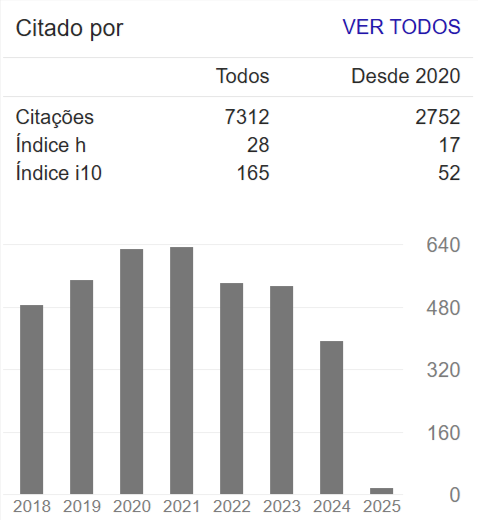Remoção de corante vermelho ácido em solução aquosa via processo Fenton
Resumo
Corantes se destacam como fontes potenciais de contaminação das águas superficiais e subterrâneas. Moléculas corantes são em geral muito recalcitrantes e podem produzir fortes impactos ambientais e à saúde humana. Entre as metodologias usadas no tratamento de efluentes coloridos relacionam-se os Processos Oxidativos Avançados (POA), com destaque para os sistemas fotolíticos com radiação UV, químicos com H2O2 e O3 e catalíticos (processos Fenton). No presente trabalho avaliou-se a capacidade de degradação do azo corante Vermelho Ácido usando o sistema oxidante Fenton com FeSO4.7H2O e H2O2. Os ensaios de degradação foram conduzidos a temperatura ambiente (25 oC), pH = 3,0 e agitação de 150 rpm segundo um planejamento fatorial para avaliação do efeito das variáveis de concentração inicial de corante (50 mg.L-1 a 150 mg.L-1), concentração de FeSO4.7H2O e concentração de H2O2 (ambas entre 33 mg.L-1 e 67 mg.L-1) sobre a remoção de corante. Experimentalmente foram encontradas degradações de corantes superiores a 93% para qualquer nível de H2O2 utilizado sob uma concentração de FeSO4.7H2O de 40 mg.L-1 após 60 minutos de tratamento. As condições ótimas de operação estimadas a partir da regressão dos valores de eficiência de degradação foram de 109,7 mg.L-1 de corante; 41,6 mg.L-1 de FeSO4.7H2O e 37,2 mg.L-1 de H2O2. Em geral, os resultados encontrados mostram o caráter promissor do processo Fenton na descoloração de azo corantes em meio aquoso.
Referências
BRASIL. MINISTÉRIO DO MEIO AMBIENTE. Resolução – RE N° 430, de 13 de maio de 2011. Dispõe sobre as condições e padrões de lançamento de efluentes, complementa e altera a resolução n° 357, de 17 de março de 2005, do Conselho Nacional do Meio Ambiente – CONAMA. 2011. http://conama.mma.gov.br/?option=com_sisconama&task=arquivo.download&id=627
CHEN, K.; WANG, G. H.; LI, W. B.; WAN, D.; HU, Q.; LU, L. L. Application of response surface methodology for optimization of Orange II removal by heterogeneous Fenton-like process using Fe3O4 nanoparticles. Chinese Chemical Letters, v. 25, p. 1455-1460, 2014.
https://doi.org./10.1016/J.CCLET.2014.06.014
CHEN, Y.; DUAN, X.; ZHOU, X.; WANG, R.; WANG, S.; REN, N. Q.; HO, S. H. Advanced oxidation processes for water disinfection: Features, mechanisms and prospects. Chemical Engineering Journal, v. 409, p. 128207, 2021. https://doi.org/10.1016/J.CEJ.2020.128207
DEZOTTI, M. C. Processos e Técnicas para o Controle Ambiental de Efluentes Líquidos. Rio de Janeiro: Série Escola Piloto de Engenharia Química, 2008. 360p.
FAYAZI, M. Preparation and characterization of carbon nanotubes/pyrite nanocomposite for degradation of Methylene Blue by a heterogeneous Fenton reaction. Journal of the Taiwan Institute of Chemical Engineers, v. 120, p. 229-235, 2021. https://doi.org/10.1016/j.jtice.2021.03.033
FERNANDES, S. M.; SOUSA, E. J. R. D; LIMA, J. R. D.; PAZ, C. B. D.; SALGADO, B. C. B.; QUEIROZ, D. C. D.; ARAÚJO, R. D. S. Oxidação Fenton do azo corante Ponceau BS usando nanopartículas de óxido de ferro como catalisador. Revista AIDIS de Ingeniería y Ciencias Ambientales. Investigacion, desarrollo y práctica. v. 14, p. 899-916, 2021. https://doi.org/10.22201/iingen.0718378xe.2021.14.2.75487
GAO, J.; LIU, Y.; XIA, X.; WANG, L.; SHAO, L.; CAI, T.; DONG, W. Mechanisms for photo assisted Fenton of synthesized pyrrhotite at neutral pH. Applied Surface Science, v. 463, p. 863-871, 2019. https://doi.org/10.1016/j.apsusc.2018.09.007
GILPAVAS, E.; DOBORSZ-GÓMEZ, I.; GÓMEZ-GARCIA, M. A. Coagulation-flocculation sequential with Fenton or Photo-Fenton processes as an alternative for the industrial textile wastewater treatment. Journal of Environmental Management, v. 191, p. 189-197, 2017. https://doi.org/10.1016/j.jenvman.2017.01.015
HASHEMI-SHAHRAKI, F.; SHAREGHI, B.; FARHADIAN, S. Characterizing the binding affinity and molecular interplay between quinoline yellow and pepsin. Journal of Molecular Liquids, v. 341, p. 117317, 2021. https://doi.org/10.1016/j.molliq.2021.117317
ITO, T.; ADACHI, Y.; YAMANASHI, Y.; SHIMADA, Y. Long–term natural remediation process in textile dye–polluted river sediment driven by bacterial community changes. Water Research, v. 100, p. 458-465, 2016. https://doi.org/10.1016/j.watres.2016.05.050
JANUÁRIO, E. F. D.; VIDOVIX, T. B.; BELUCI, N. C. L.; PAIXÃO, R. M.; SILVA, L. H. B. R.; HOMEM, N. C.; BERGAMASCO, R.; VIEIRA, A. M. S. Advanced graphene oxide-based membranes as a potential alternative for dyes removal: A review. Science of Total Environment, v. 789, p. 147957, 2021. https://doi.org/10.1016/j.scitotenv.2021.147957
JAVAID, R.; QAZI, U. Y. Catalytic oxidation process for the degradation of synthetic dyes: An overview. International Journal of Environmental Research and Public Health, v. 16, n. 11, p. 2066, 2019. https://doi.org/10.3390/ijerph16112066
KARTHIKEYAN, S.; TITUS, A.; GNANAMAMI, A.; MANDAL, A. B.; SEKARAN, G. Treatment of textile wastewater by homogeneous and heterogeneous Fenton oxidation processes. Desalination, v. 281, p. 438-445, 2011. https://doi.org/10.1016/j.desal.2011.08.019
LONG, X.; YANG, Z.; WANG, H.; CHEN, M.; PENG, K.; ZENG, Q.; XU, A. Selective degradation of Orange II with the cobalt(II)–bicarbonate–hydrogen peroxide system. Ind. Eng. Chem. Res. v. 51, p. 11998–12003, 2012. https://doi.org/10.1021/ie3013924
MACÍAS-QUIROGA, I. F.; ROJAS-MÉNDEZ, E. F.; GIRALDO-GÓMEZ, G. I.; SANABRIA-GONZÁLEZ, N. R. Experimental data of a catalytic decolorization of Ponceau 4R dye using the cobalt (II)/NaHCO3/H2O2 system in aqueous solution. Data in Brief, v. 30, p. 105-463, 2020.
https://doi.org/10.1016/j.dib.2020.105463
MARTÍNEZ-HUITLE, C. A.; BRILLAS, E. Decontamination of wastewaters containing synthetic organic dyes by electrochemical methods: A general review. Applied Catalysis B: Environmental, v. 87, p. 105-145, 2009. https://doi.org/10.1016/j.apcatb.2008.09.017
MASARBO, R. S.; NIRANJANA, S. R.; MONISHA, T. R.; NAYAKA, A. S.; KAREGOUDAR, T. B. Efficient decolorization and detoxification of sulphonated azo dye Ponceau 4R by using single and mixed bacterial consortia. Biocatalysis and Biotransformation, v. 37, p. 367-376, 2019.
https://doi.org/10.1080/10242422.2019.1568414
MODAK, J. B.; BHOWAL, A.; DATTA, S.; KARMAKAR, S. Continuous decolorization of dye solution by homogeneous Fenton process in a rotating packed bed reactor. International Journal of Environmental Science and Technology, v. 17, p. 1691-1702, 2020.
https://doi.org/10.1007/s13762-019-02548-4
MOSSMAN, A.; DOTTO, G. L.; HOTZA, D.; JAHN, S. L.; FOLETTO, E. L. Preparation of polyethylene-supported zero-valent iron buoyant catalyst and its performance for Ponceau 4R decolorization by photo-Fenton process. Journal of Environmental Chemical Engineering, v. 7, p. 102963, 2019. https://doi.org/10.1016/j.jece.2019.102963
NOGUEIRA, R. F. P.; OLIVEIRA, M. C.; PATERLINI, W. C. Simple and fast spectrophotometric determination of H2O2 in photo-Fenton reactions using metavanadate. Talanta, v. 66, p. 86-91, 2005. https://doi.org/10.1016/j.talanta.2004.10.001
PARSONS, S. Advanced Oxidation Processes for Water and Wastewater Treatment. IWA Publishing, 1st ed., 356 p., 2004. ISBN: 978-1843390176.
PAULINO, T. R. S.; ARAÚJO, R. S.; SALGADO, B. C. B. Estudo de oxidação avançada de corantes básicos via reação Fenton (Fe2+/H2O2). Engenharia Sanitária e Ambiental, v. 20, p. 347-352, 2015. https://doi.org/10.1590/S1413-41522015020000111627
REKHATE, C. V.; SRIVASTAVA, J. K. Recent advances in ozone-based advanced oxidation processes for treatment of wastewater - A review. Chemical Engineering Journal Advances, v. 3, p. 100031, 2020. https://doi.org/10.1016/j.ceja.2020.100031
RIVERA, F.L.; RECIO, F. J.; PALOMARES, F. J.; SÁNCHEZ-MARCOS, N.; MENÉNDEZ, N.; MAZARIO, E.; HERRASTI, P. Fenton-like degradation enhancement of Methylene Blue dye with magnetic heating induction. Journal of Electroanalytical Chemistry, v. 879, p. 114773, 2020.
https://doi.org/10.1016/j.jelechem.2020.114773
SAEED, M. O.; AZIZLI, K.; ISA, M. H.; BASHIR, M. J. K. Application of CCD in RSM to obtain optimize treatment of POME using Fenton oxidation process. Journal of Water Process Engineering, v. 8, p. 7-16, 2015. https://doi.org/10.1016/j.jwpe.2014.11.001
SALDANÃ-ROBLES, A.; GUERRA-SÁNCHEZ, R.; MALDONADO-RUBIO, M. I.; PERALTA-HERNÁNDEZ, J. M. Optimization of the operating parameters using RSM for the Fenton oxidation process and adsorption on vegetal carbon of MO solutions. Journal of Industrial and Engineering Chemistry, v. 20, p. 848-857, 2014. https://doi.org/10.1016/j.jiec.2013.06.015
SHARIFPOUR, E.; ARABKHANI, P.; SADEGH, F.; MOUSAVIZADEH, A.; ASFARAM, A. In-situ hydrothermal synthesis of CNT decorated by nano ZnS/CuO for simultaneous removal of acid food dyes from binary water samples. Scientific Reports, v. 12, p. 12381, 2022.
https://doi.org/10.1038/s41598-022-16676-4
SU, C. C.; PUKDEE-ASA, M.; RATANATAMSKUJ, C.; LU, M. C. Effect of operating parameters on decolorization and COD removal of three reactive dyes by Fenton's reagent using fluidized-bed reactor. Desalination, v. 278, p. 211-218, 2011. https://doi.org/10.1016/j.desal.2011.05.022
TAVARES, M. G. R.; SANTOS, D. H. S.; TAVARES, M. G.; DUARTE, J. L. S.; MEILI, L.; PIMENTEL, W. R. O.; TONHOLO, J.; ZANTA, C. L. P. S. Removal of reactive dyes from aqueous solution by Fenton reaction: Kinetic study and phytotoxicity tests. Water, Air, and Soil Pollution, v. 231, p. 1-15, 2020. https://doi.org/10.1007/s11270-020-4465-6
THIAM, A.; BRILLAS, E.; GARRIDO, J. A.; RODRÍGUEZ, R. M.; SIRÉS, I. Routes for the electrochemical degradation of the artificial food azo-colour Ponceau 4R by advanced oxidation processes. Applied Catalysis B: Environmental, v. 180, p. 227-236, 2016.

















